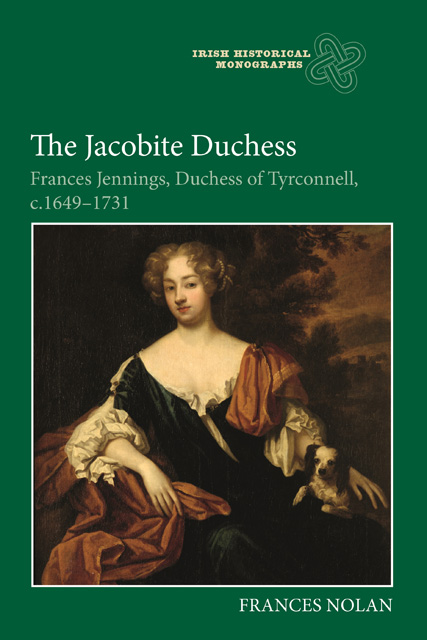Book contents
- Frontmatter
- Dedication
- Contents
- List of illustrations
- Acknowledgements
- List of abbreviations
- Notes on the text
- Introduction
- 1 ‘The malicious little gipsy’: Early life, c.1649–65
- 2 ‘Hambleton is now going into France’: Marriage, motherhood and migration, 1666–76
- 3 ‘Ruined beyond redemption’?: Widowhood, remarriage and returning, 1676–86
- 4 ‘That caballing humour’: A political woman, 1687–90
- 5 ‘Every one’s eye is watching’: Treason, forfeiture and exile, 1691–99
- 6 ‘Always a plane dealor’: Changing fortunes and life in the Low Countries, 1700–08
- 7 ‘A duchess-nun’?: Family, faith and finance in old age, 1708–30
- 8 ‘Albion’s fairest plant’: Death and legacy, 1731
- Appendix A: Duchess of Tyrconnell’s family tree
- Appendix B: Books in the possession of the duchess of Tyrconnell in Dublin, transported from her apartment in the Château de Saint-Germain-en-Laye
- Appendix C: David Nairne’s ‘Cyffer w[i]th the D[uche]sse of Tyrconnel, 5th August 1702’
- Bibliography
- Index
- Irish Historical Monographs previous volumes
2 - ‘Hambleton is now going into France’: Marriage, motherhood and migration, 1666–76
Published online by Cambridge University Press: 04 January 2024
- Frontmatter
- Dedication
- Contents
- List of illustrations
- Acknowledgements
- List of abbreviations
- Notes on the text
- Introduction
- 1 ‘The malicious little gipsy’: Early life, c.1649–65
- 2 ‘Hambleton is now going into France’: Marriage, motherhood and migration, 1666–76
- 3 ‘Ruined beyond redemption’?: Widowhood, remarriage and returning, 1676–86
- 4 ‘That caballing humour’: A political woman, 1687–90
- 5 ‘Every one’s eye is watching’: Treason, forfeiture and exile, 1691–99
- 6 ‘Always a plane dealor’: Changing fortunes and life in the Low Countries, 1700–08
- 7 ‘A duchess-nun’?: Family, faith and finance in old age, 1708–30
- 8 ‘Albion’s fairest plant’: Death and legacy, 1731
- Appendix A: Duchess of Tyrconnell’s family tree
- Appendix B: Books in the possession of the duchess of Tyrconnell in Dublin, transported from her apartment in the Château de Saint-Germain-en-Laye
- Appendix C: David Nairne’s ‘Cyffer w[i]th the D[uche]sse of Tyrconnel, 5th August 1702’
- Bibliography
- Index
- Irish Historical Monographs previous volumes
Summary
The decline in plague dead by the spring of 1666 promised an upturn in London’s fortunes; as it was, the year became one of the city’s worst. The morbid procession of the plague was followed by the rampant destruction of the Great Fire, which broke out in Pudding Lane just after midnight on 2 September. The fire, described by John Evelyn as ‘a miserable and calamitous spectacle, such as haply the world had not seen since the foundation of it’, raged through the medieval City of London for three days, before dying winds helped to bring it under control. At its height, the clouds of smoke generated by the blaze were fifty miles in length and the sky at night ‘was light as day for ten miles round about’. Upriver, Whitehall and Westminster were threatened, but in the end the king and his court sat far enough from the City to escape the devastation. Among them was Frances Jennings, newly married to George Hamilton, living in a house in Dean’s Yard beside Westminster Abbey, and in the early months of her first pregnancy. Frances likely watched the smoke-filled London sky and heard stories of destruction as the fire spread through the City, ‘leaping’ as Evelyn put it, ‘after a prodigious manner, from house to house and from street to street, at great distances’. She could not have known then that her marriage and the political fallout of the disaster would conspire to change her life irrevocably, taking her away from England and into France.
Frances’s new husband, George Hamilton, was a member of a Scots-Irish family of noble rank. Probably born in Roscrea, County Tipperary in the 1630s, he was the second son of Sir George Hamilton of Donalong, County Tyrone, (who was himself the fourth son of James, earl of Abercorn), and Mary (née Butler). Through his mother he was the nephew of James Butler, duke of Ormond. Marrying just two years after her arrival in London, Frances had adhered to at least part of the maxim attributed to her in the Memoirs: she had entered the court with the advantage of youth and was ‘not [too] old to leave it with a good grace’.
- Type
- Chapter
- Information
- The Jacobite DuchessFrances Jennings, Duchess of Tyrconnell, c.1649-1731, pp. 37 - 59Publisher: Boydell & BrewerPrint publication year: 2021

